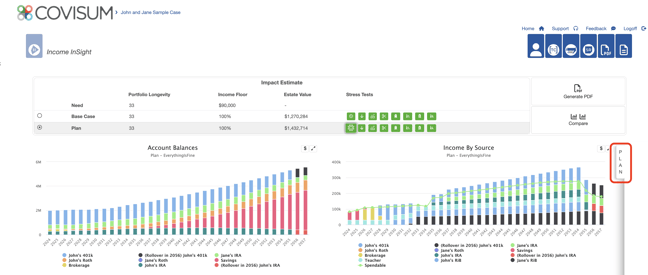Customizable Retirement Strategies
Once a "Base Case" has been entered with all appropriate information and the results are generated, changes can be made to various assumptions based on the success or failure of key plan metrics (Portfolio Longevity, Income Floor and the Estate Value) or the Stress Tests applied to the "Base" Case scenario.
In order to modify a plan, click on the "Plan" tab located on the right side of the results screen, as outlined in red below.

From there, ten different options exist:

- Refine Spending: Allows for adjustments to spending patterns created in the Base Case.
- Change SS Strategy: Used to illustrate the benefits and trade-offs on earning Delayed Retirement Credits (DRCs) within Social Security.
- Change Harvesting Patterns: Shows the impact of taking qualified assets first or considering Roth conversions. Roth conversions are determined based on the client's Effective Marginal Rate (EMR) or the average EMR.
- Add Deferred Annuity: A fixed or indexed deferred annuity can provide protection in a down market and lifetime income. Qualifed Longevity Annuity Contracts (QLACs) may also be considered.
- Add Permanent Life: Permanent life insurance has many advantages for a retirement income plan including, but not limited to, a tax-free death benefit, tax-free income (when structured properly) and accelerated death benefit riders for chronic illness and long term care needs.
- Add Term Life: Affordable coverage for a defined number of years.
- Add Single Premium Immediate Annuities (SPIA): Income annuities can provide lifetime income and are often combined with other guaranteed income sources, such as Social Security or pensions to cover basic needs.
- Refine Health Insurance: Change or add health insurance.
- Reallocate Portfolio: This planning option allows for the reallocation of the portfolio to a pre-defined level (conservative, moderate or aggressive) or a custom model portfolio. Reallocation can be used to examine overall risk/reward dynamics, and the changes will impact the down-market stress test results.
